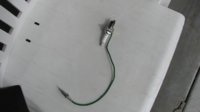madjap
XS650 Addict
Wanna make sure I'm gonna do this right. ONLY reference I saw to it in Tech section refers to 'earthing the lead'... So, do I need to pull my spark plug wire off and ground it to the motor??? I have the stock dual points on my bike, I'm running a dual output / single fire coil and BOTH my points are tied together at the coil. My bike WON'T run if I simply pull a plug wire off one side, it will die even at high RPM if that happens.

